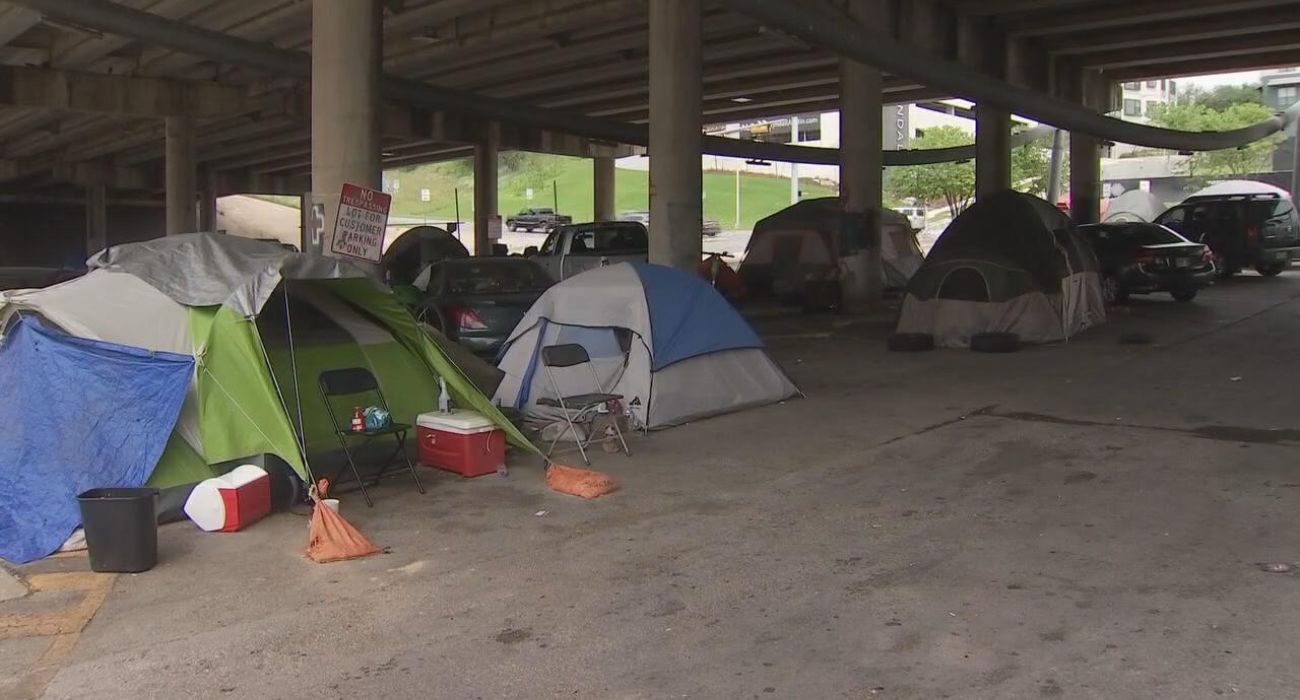In a presentation to members of the Housing and Homeless Solutions Committee on Monday, Housing Forward CEO Sarah Kahn said the organization’s efforts are seeing success, but some council members questioned that data and whether other entities are pulling their weight in addressing the issue.
Housing Forward is a nonprofit working to address homelessness in Dallas and Collin Counties. It is the lead organization of the All Neighbors Coalition, a collective of more than 140 organizations providing resources and support for the homeless.
“I had reported to this committee previously that we have been really transforming our approach to how we respond to homelessness in Dallas and Collin County,” especially as it relates to veterans, families, and youth, she said.
“Today’s conversation is really going to zero in on strategies for resolving unsheltered homelessness. … Unsheltered homelessness is also a health crisis for those enduring life outside.”
Much of the discussion regarding the All Neighbors Coalition quarterly report centered on how Housing Forward is working to reduce the number of people experiencing streetside homelessness, the data it uses to justify its efforts, and how other communities in North Texas are allowing Dallas to shoulder that burden.
“We’ve made some real progress over the last couple of years,” Kahn claimed. “Our system is housing more people than ever before. Since the R.E.A.L. time investment, we’re housing three times more people than we were in 2019 and 2020. … This new way of working together has also created an environment where we have decreased homelessness, while national rates have really soared to record highs over the last couple of years.”
In addition to Dallas and the Dallas Housing Authority, Housing Forward works with Plano, Mesquite, and Dallas County to rehouse those experiencing homelessness. More than a dozen organizations, including nonprofits, are All Neighbors Coalition participants.
“We were able to attract more public and private investment last year that has allowed since May to … start to scale additional pathways out of homelessness beyond just rapid rehousing. Diversion brings housing solutions to the front door of our homeless-response system. In shelters, we have diversion case managers … who can help individuals and families immediately resolve their housing crisis and get people back into housing.”
As previously reported by The Dallas Express, “Housing First” strategies have been heavily criticized by experts for failing to address the root causes of homelessness, such as mental illness and drug addiction.
Meanwhile, polling conducted by DX has illustrated that some 75% of Dallas voters consider homelessness and vagrancy to be “major” problems in the city. Data also indicates that Dallas residents are generally supportive of a “one-stop-shop” approach to addressing homelessness, such as the method employed by Haven for Hope in San Antonio, which some Dallas local stakeholders are looking to emulate. The model has been credited with a 77% reduction in unsheltered homelessness in downtown San Antonio.
Housing Forward hopes to reduce chronic unsheltered homelessness, “effectively” end veteran homelessness, and “significantly” reduce family and youth homelessness to house 2,700 individuals and families in North Texas over the next two years.
“We understand the challenges that unsheltered homelessness continues to cause for our communities,” Kahn said. “While the strategies are working, we need to go bigger, and we need to go faster. … There are some new things that we are putting in place this year to allow us to do that.”
Since May 2023, 324 people in Dallas and Collin counties have reportedly found housing through permanent supportive housing, and 2,405 individuals and people in families have been housed through diversion over the same period.
At each level of homelessness — sheltered and unsheltered, chronic and nonchronic — 96% of those who were “engaged” by advocates said “yes” to housing, the Housing Forward report suggests.
But District 12 Council Member Cara Mendelsohn, vice chair of the committee, challenged these figures and questioned whether advocacy organizations are doing enough to reduce the City’s homelessness.
“I’m just going to tell you that we’re seeing more homelessness — not less,” she said. “You have something in here that says maybe 96 or something percent say ‘yes’ to housing. No, they don’t. They just don’t. That’s not true. … You’re not moving everybody into housing. There’s people who don’t want it, and I think you know that’s true.”
She also said that the federal point-in-time method used by the U.S. Department of Housing and Urban Development to collect data on the number of people experiencing homelessness on a given day in January at least every other year does not provide an accurate picture of such data. Kahn agreed, saying it merely captures “trends” in a city’s homeless population.
Continuums of care must conduct point-in-time counts, as well as housing inventory counts, at least bi-annually. However, point-in-time counts do not necessarily include data on the number of people experiencing homelessness who are temporarily living in shelters and hotels or with friends or relatives.
“So we’re estimating for needing rehousing interventions over the course of the year for about 7,000 single adults,” Kahn said. “People keep coming into the system … but we’re leaving a lot of people behind in long-term homelessness. … We have real gaps in housing exits, and what we need to do is sort of invert that funnel and to make sure that we’re shrinking inflow into the system, providing more housing exits, and that creates a situation where shelter beds free up [and] we can reduce unsheltered homelessness.”
In 2023, about 255,000 people across the U.S. were considered unsheltered, according to the Housing Forward report. Over the same period, that number was about 1,200 in the Dallas and Collin continuums of care.
“I have to tell you that it’s about time we have some kind of resolution that says we are one of many cities within the CoC, and it’s time for other cities to start stepping up,” Mendelsohn said. “What we’re doing is taking people who are homeless and who are ending their homeless [sic] coming back to Dallas — always. And when we look at poverty rates, it’s very clear that Dallas is by far the highest poverty area within Dallas County and within our entire region.”
Meanwhile, Housing Forward in February moved 30 people from encampments at Routh Street & Woodall Rodgers Freeway and Buckner Boulevard & Interstate 30 into housing.
“The encampment rehousing process that we are expanding as we speak and have been scaling since January,” Kahn said. “We also then refer people to permanent supportive housing, which is a provider who is paying the rent. … We’re actively closing four sites currently.”
Mendelsohn was not satisfied with that explanation.
“I think there’s something way off base here,” she said. “If we fenced off every encampment — all 400-plus encampments, our city would look terrible.”
Mendelsohn also said she photographed people last weekend “drugged out” near the road.
“They’re literally laying with their head inches from the roadway of cars going 50 plus miles per hour, with 55,000 cars per day going by. They’re drugged out. … This is a terrible way for them to exist, and they are living off petty crimes and, you know, that’s not being addressed. And I have all the compassion in the world for the person who has had a series of unfortunate events and needs some help.”
The reference to fencing encampments is from the Housing Forward report that asserts “what’s needed from the city” is “consistent encampment closure maintenance — patrolling, fencing, signage, etc.”
District 1 Council Member Chad West said, “It’s essential for our regional partners to step up and do their share.”
“We want to be a good regional partner,” he said. “I think we’ve been a fantastic regional partner. … I disagree with my colleague on the usefulness of the point-in-time count. I know it’s not perfect, but it’s the nationally recognized data-collection tool.”
West also addressed Mendelsohn’s comment about “drugged out” people near interstates and freeways.
“I’ve seen that myself, as well,” he said. “And this is a terrible analogy, but the only one that comes to mind is like when you are taking on the homelessness situation, you want to get the lowest hanging fruit first.”
That means that intervention is most impactful when it is used to divert people who are new to homelessness, West said.
Another member of the committee, District 13 Council Member Gay Donnell Willis, stressed compassion for the homeless.
“I’m going to go back to the empathy that we feel, the compassion side,” she said. “I do feel empathy [for] those who cannot make a decision for themselves because they may be in some sort of state where they just can’t. And so, I feel like that’s where we need to redefine what compassion is. It may be compassion to enforce.”
During the point-in-time count in January 2023 in Dallas and Collin counties, more than 4,200 homeless people were tallied, with 28% of those people considered unsheltered. Nearly 22% of the total homeless population were 55 to 64 years old, and almost 88% were in Dallas County.






